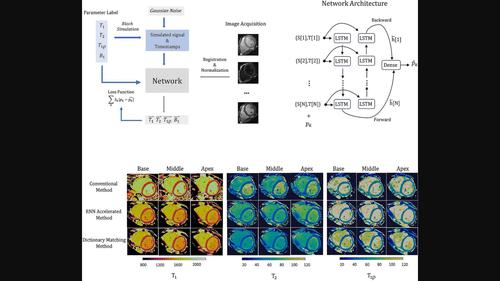当前位置:
X-MOL 学术
›
NMR Biomed.
›
论文详情
Our official English website, www.x-mol.net, welcomes your feedback! (Note: you will need to create a separate account there.)
Recurrent neural network‐based simultaneous cardiac T1, T2, and T1ρ mapping
NMR in Biomedicine ( IF 2.9 ) Pub Date : 2024-03-23 , DOI: 10.1002/nbm.5133 Yiming Tao 1 , Zhenfeng Lv 1 , Wenjian Liu 1 , Haikun Qi 2, 3 , Peng Hu 2, 3
NMR in Biomedicine ( IF 2.9 ) Pub Date : 2024-03-23 , DOI: 10.1002/nbm.5133 Yiming Tao 1 , Zhenfeng Lv 1 , Wenjian Liu 1 , Haikun Qi 2, 3 , Peng Hu 2, 3
Affiliation

|
The purpose of the current study was to explore the feasibility of training a deep neural network to accelerate the process of generating T1, T2, and T1ρ maps for a recently proposed free‐breathing cardiac multiparametric mapping technique, where a recurrent neural network (RNN) was utilized to exploit the temporal correlation among the multicontrast images. The RNN‐based model was developed for rapid and accurate T1, T2, and T1ρ estimation. Bloch simulation was performed to simulate a dataset of more than 10 million signals and time correspondences with different noise levels for network training. The proposed RNN‐based method was compared with a dictionary‐matching method and a conventional mapping method to evaluate the model's effectiveness in phantom and in vivo studies at 3 T, respectively. In phantom studies, the RNN‐based method and the dictionary‐matching method achieved similar accuracy and precision in T1, T2, and T1ρ estimations. In in vivo studies, the estimated T1, T2, and T1ρ values obtained by the two methods achieved similar accuracy and precision for 10 healthy volunteers (T1: 1228.70 ± 53.80 vs. 1228.34 ± 52.91 ms, p > 0.1; T2: 40.70 ± 2.89 vs. 41.19 ± 2.91 ms, p > 0.1; T1ρ: 45.09 ± 4.47 vs. 45.23 ± 4.65 ms, p > 0.1). The RNN‐based method can generate cardiac multiparameter quantitative maps simultaneously in just 2 s, achieving 60‐fold acceleration compared with the dictionary‐matching method. The RNN‐accelerated method offers an almost instantaneous approach for reconstructing accurate T1, T2, and T1ρ maps, being much more efficient than the dictionary‐matching method for the free‐breathing multiparametric cardiac mapping technique, which may pave the way for inline mapping in clinical applications.
中文翻译:

基于循环神经网络的同步心脏 T1、T2 和 T1ρ 映射
当前研究的目的是探索训练深度神经网络以加速为最近提出的自由呼吸心脏多参数映射技术生成 T1、T2 和 T1ρ 图的过程的可行性,其中循环神经网络 (RNN)用于利用多对比度图像之间的时间相关性。基于 RNN 的模型是为了快速准确地估计 T1、T2 和 T1ρ 而开发的。通过 Bloch 模拟来模拟超过 1000 万个信号和不同噪声水平的时间对应的数据集,用于网络训练。将所提出的基于 RNN 的方法与字典匹配方法和传统映射方法进行比较,分别评估模型在 3 T 的体模和体内研究中的有效性。在模型研究中,基于 RNN 的方法和字典匹配方法在 T1、T2 和 T1ρ 估计中实现了相似的准确度和精确度。在体内研究中,通过两种方法获得的估计 T1、T2 和 T1ρ 值对 10 名健康志愿者实现了相似的准确度和精密度(T1:1228.70 ± 53.80 vs. 1228.34 ± 52.91 ms,p > 0.1; T2:40.70 ± 2.89 与 41.19 ± 2.91 毫秒,p > 0.1; T1ρ:45.09 ± 4.47 与 45.23 ± 4.65 毫秒,p > 0.1)。基于RNN的方法可以在短短2秒内同时生成心脏多参数定量图,与字典匹配方法相比实现了60倍的加速。 RNN 加速方法提供了一种几乎即时的方法来重建准确的 T1、T2 和 T1ρ 映射,比自由呼吸多参数心脏映射技术的字典匹配方法更有效,这可能为内联映射铺平道路。临床应用。
更新日期:2024-03-23
中文翻译:

基于循环神经网络的同步心脏 T1、T2 和 T1ρ 映射
当前研究的目的是探索训练深度神经网络以加速为最近提出的自由呼吸心脏多参数映射技术生成 T1、T2 和 T1ρ 图的过程的可行性,其中循环神经网络 (RNN)用于利用多对比度图像之间的时间相关性。基于 RNN 的模型是为了快速准确地估计 T1、T2 和 T1ρ 而开发的。通过 Bloch 模拟来模拟超过 1000 万个信号和不同噪声水平的时间对应的数据集,用于网络训练。将所提出的基于 RNN 的方法与字典匹配方法和传统映射方法进行比较,分别评估模型在 3 T 的体模和体内研究中的有效性。在模型研究中,基于 RNN 的方法和字典匹配方法在 T1、T2 和 T1ρ 估计中实现了相似的准确度和精确度。在体内研究中,通过两种方法获得的估计 T1、T2 和 T1ρ 值对 10 名健康志愿者实现了相似的准确度和精密度(T1:1228.70 ± 53.80 vs. 1228.34 ± 52.91 ms,



























 京公网安备 11010802027423号
京公网安备 11010802027423号